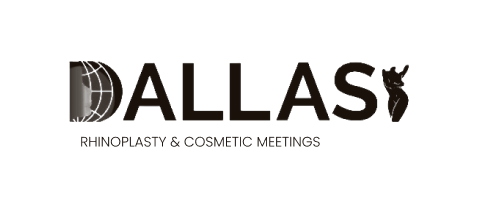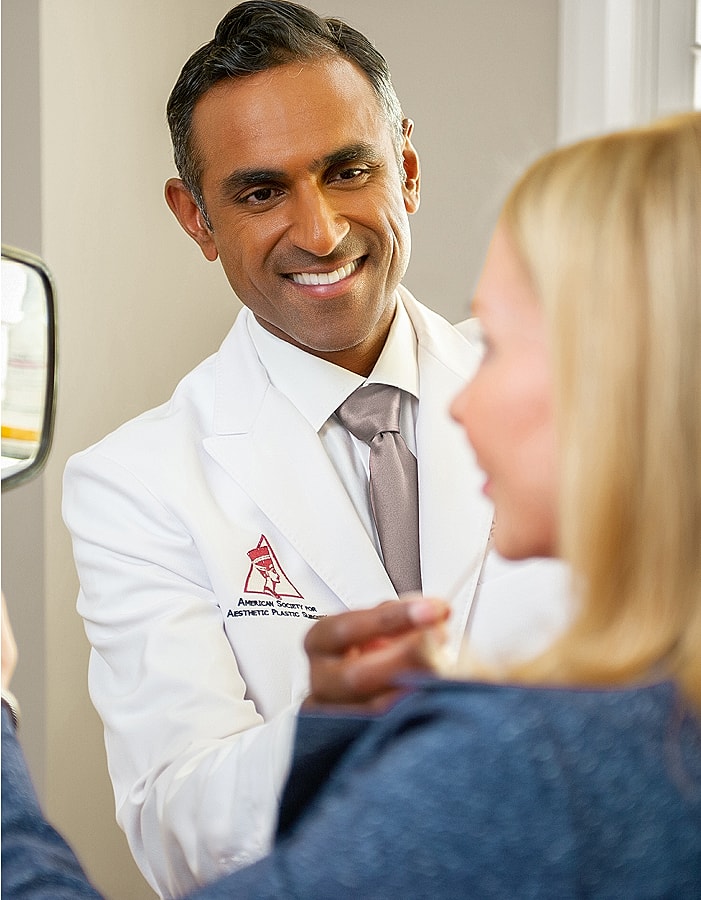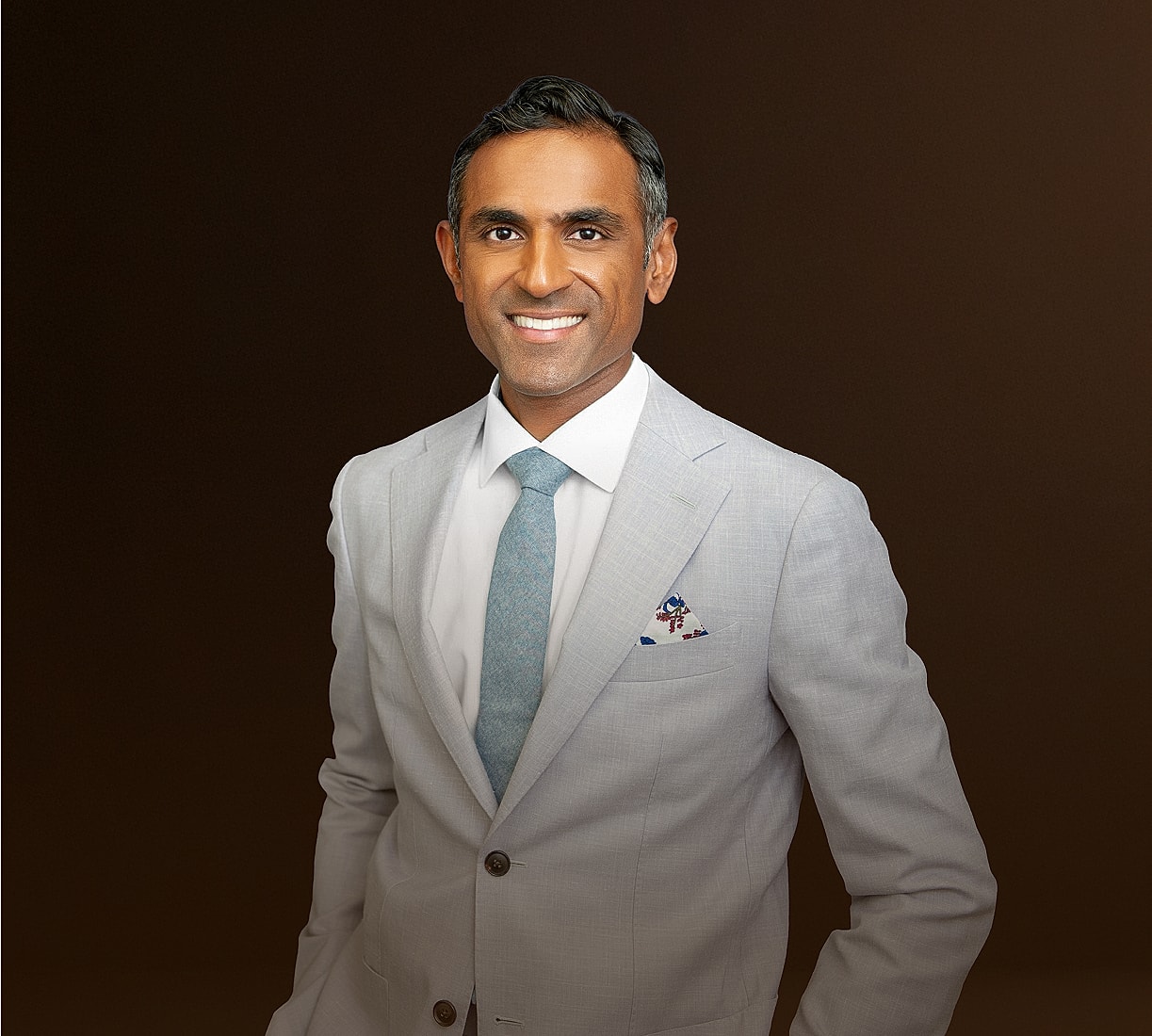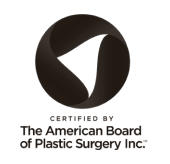
Deep Plane Facelift in Tampa & St. Petersburg

















A variety of factors influence your skin’s tone and elasticity, which affect your signs of aging. When your skin loses tone and elasticity, the rate at which visible signs of aging occur increases.
Two protein molecules are responsible for your skin tone and elasticity: collagen and elastin. Therefore, a decrease in these molecules causes a decrease in tone and elasticity, resulting in an increase in wrinkles, fine lines, dryness, and other signs of aging. Other factors that can influence the speed of skin aging include genetics, gravity, exposure to environmental toxins, and sun damage.
When you experience these changes and find that skincare products do not achieve your desired changes, consider a deep plane facelift in Tampa. Double board-certified plastic surgeon, Dr. Narasimhan, will evaluate your cosmetic concerns in a consultation and make the best facial plastic surgery recommendations to help you meet your aesthetic goals and feel like your best self again.

The deep plane facelift technique repositions the deeper muscles and connective tissue layers—beyond the superficial musculoaponeurotic system (SMAS)—to lift sagging mid-face and neck soft tissue. This facial plastic surgery approach stretches underlying muscles and fat, not just facial skin, to create a more naturally youthful appearance while reducing deep wrinkles and severe skin laxity. The surgery also helps to smooth wrinkles and folds and may include a neck lift, as the two areas are interrelated. This procedure corrects the jowls, cheek ligaments, cheek fat pads, and muscles. Lifting the cheek fat pads can reduce nasal labial folds, contributing to a more youthful shape.
As with other types of facelift techniques, a deep plane facelift can be combined with other procedures for people in Tampa, such as a forehead lift, liposuction, fat transfer, or laser skin resurfacing. The facelift can be enhanced with skin rejuvenating treatments, allowing you to experience not only the transformation of your facial structure but also the rejuvenation and radiance of your skin.
The deep plane rhytidectomy procedure offers numerous benefits, including maintaining a natural blood supply to the skin, which results in reduced post-operative pain, faster healing, improved skin laxity, and more substantial and natural-looking results. This procedure requires a highly skilled and experienced plastic surgeon, as well as more surgical time than a standard facelift, which can be costly but is often considered worthwhile.

Our surgeon in Tampa typically does the deep plane facelift on an outpatient basis. Unlike other less invasive procedures, a deep plane facelift requires general anesthesia, so you are asleep throughout the surgical procedure, which can take three or more hours.
After a doctor administers the anesthesia, your surgeon will make an incision around the ear and in the hairline, so the scar is as invisible as possible. The skin and underlying layers are lifted and repositioned together to eliminate sagging skin. The incisions are then carefully closed, often with the use of drains, to support healing. Surgery typically lasts 3 to 4 hours. Cold packs are used to reduce swelling and support the healing process.
The plastic surgeon typically inserts small drainage tubes to prevent fluid from accumulating behind the incisions. These are typically removed at the first follow-up visit.

This procedure targets deeper muscles and soft tissues across the mid-face, jowls, cheeks, neck, and jawline, delivering a comprehensive facial rejuvenation.

The ideal candidate will have mild to moderate skin laxity and typically falls within the age range of 40 to 60. People in Tampa seeking treatment for skin sagging from the mid-face to the neck are typically satisfied with a deep plane facelift that considers their facial anatomy.
Before surgery, Dr Narasimhan evaluates your medical history and cosmetic concerns and reviews several simulations with you, so you have the information you need to make an informed decision.
Those who are taking prescribed medications, over-the-counter drugs, or supplements that can increase the risk of bleeding during surgery should discuss altering the medication or schedule with the prescribing physician before surgery.
Smoking presents unique challenges and increases the risk of complications during surgery and while healing. We highly recommend that you stop smoking or using nicotine four weeks before and after the surgery. This includes any tobacco products, vaping, nicotine gum, or nicotine patches. Nicotine also slows the body’s production of collagen and elastin. Over time, this can negatively affect the results of a deep plane facelift.
It is crucial to have realistic expectations of the surgical results and commit to making lifestyle decisions that will help prolong the results, such as getting quality sleep, eating nutritious food, staying hydrated, and using sun protection. The Deep Plane Facelift is not ideal for early aging or poor skin elasticity; these patients may benefit from SMAS or mini facelifts.

You can take several steps to help prepare for a deep plane facelift while living in Tampa. Preparation is key to experiencing the best results and the smoothest recovery time. In addition to adjusting medications, supplements, and smoking habits, you should also limit or eliminate your alcohol consumption, as this can affect your immune system and recovery.
Weight fluctuations can negatively impact the results of a facelift, so maintaining a healthy diet and staying hydrated can help protect your results and aid in the healing process. Before the day of surgery, prepare a designated area in your home where you can rest and recover, ensuring easy access to essentials such as water, a telephone, medications, and entertainment.
You will go home on the same day as surgery and must have someone to drive you home and stay for the first several days during your recovery. Dr. Narasimhan will give you detailed post-operative instructions that you must follow carefully. This helps to reduce the risk of complications, including infection, and improves healing.
First 48 hrs: Head elevated, cold packs to reduce swelling
Days 3–7: Most swelling and bruising improve; you may begin light activity
Weeks 2–4: Gradual return to moderate exercise
Months 3–6: Final results ebb as deeper tissues settle
You’ll need pain medication initially and follow-up visits to support a smooth recovery.

Results begin to show as early as 2–3 months, with full effects visible at 6–12 months as the deep tissues settle. Most patients enjoy a dramatic yet natural rejuvenation that lasts up to a decade, far exceeding the longevity of traditional facelifts.
During your deep plane surgery consultation with Dr. Narasimhan, he will address your questions, assess your facial structure, and utilize advanced simulation technology to demonstrate how the recommendations can minimize the visible signs of aging and help restore your youthful beauty.
We encourage you to call to schedule your consultation to consider a deep plane facelift consultation in Tampa and facial rejuvenation procedures that can enhance your self-confidence and self-image.

Dr. Narasimhan’s passion for plastic surgery is evident in his impressive credentials, which include:
American Board of Plastic Surgery and American Board of Otolaryngology (Head & Neck Surgery)
Guest faculty at internationally renowned cosmetic surgery meetings, such as the Dallas Cosmetic Symposium
No—pain is similar, but recovery may be smoother because deeper tissues support skin without tension.
As with any surgery, risks include bleeding, infection, and rare nerve injury; Dr. Narasimhan minimizes risk through precise technique.
Most patients return to moderate exercise around 4 weeks post-op; light walking begins within 1 week.
Yes—many patients combine facial procedures for a comprehensive rejuvenation under one anesthesia session.
Yes—the deep plane technique repositions facial muscles and connective tissue in a way that preserves your natural features and expressions.






